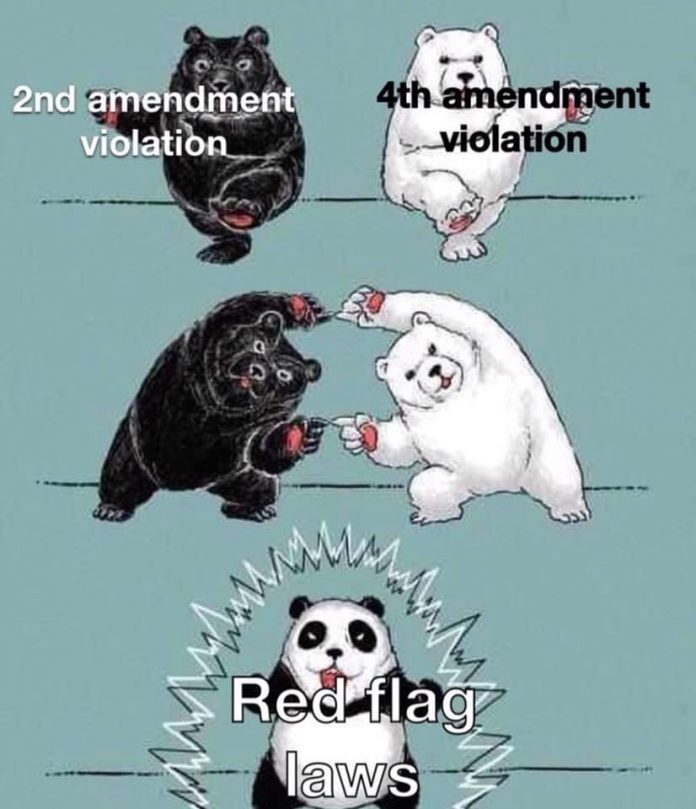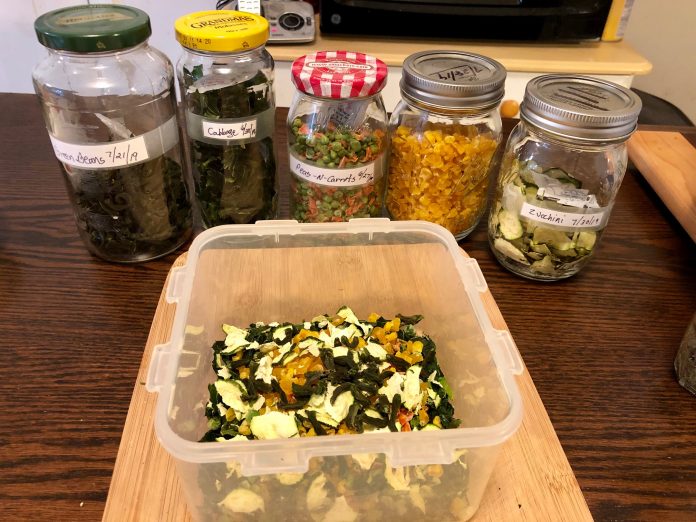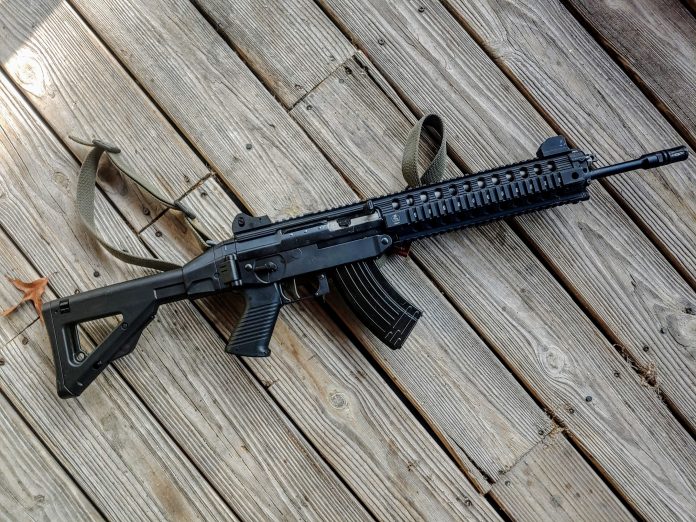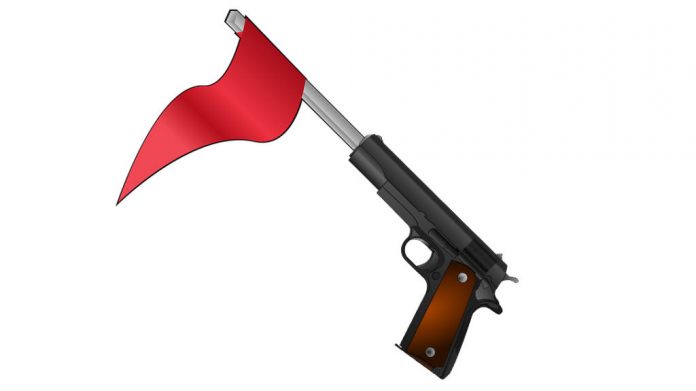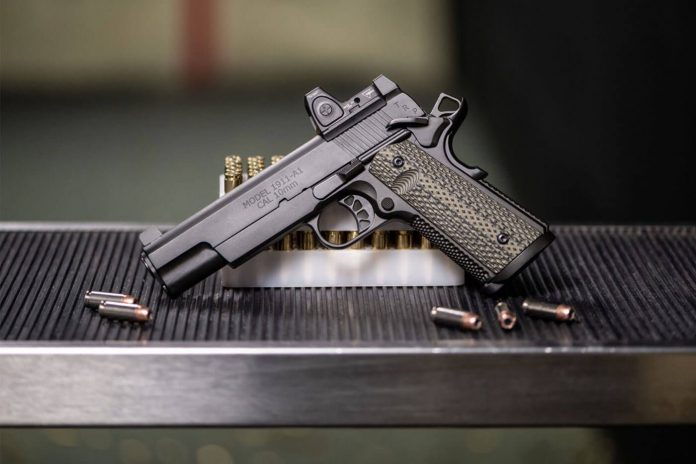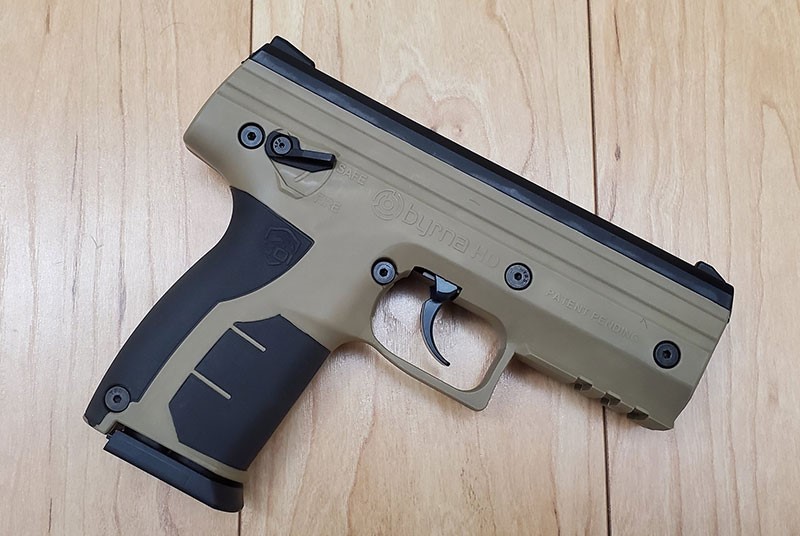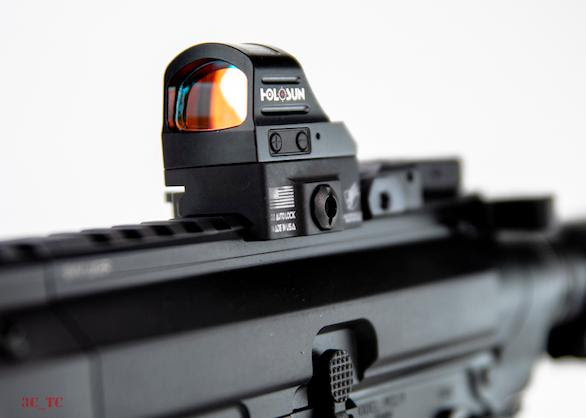It’s a new kind of Gear Up! No more waiting for products in the mail – now you select an Instant Gear Up firearm from a list of qualifying models, contact your retailer, ask for “Springfield Instant Gear Up”, and pick up your new gun and free gear at the same time! It’s up to a $230 value FREE!
Springfield Instant Gear Up
Ohio: ERPO’s and Constitutional Carry
The legislature in the Ohio is currently considering two very different ends of the spectrum when it comes to gun laws. On the one end a bill was introduced, H.B. 316, that would allow family members, roommates, and LEOs to flag someone temporarily (for 180 days) and have their firearms confiscated and be prevented from purchasing any new ones. On the other end HB 174 and 178 would make Ohio a constitutional carry state for residents over 21 years of age and remove the duty to inform clause and a provision to revoke conviction under that clause.
So ultimately the legislative landscape isn’t all bad. Texas recently passed a myriad of pro self defense measures that threw the mainstream media into an apoplexy. They couldn’t fathom why increasing the ease with which law abiding citizens could protect themselves and shoot back in a situation like El Paso might drastically curb the casualties caused in a future incident?
“But Keith, you dunce, that’s what all the gun control is for! ERPO’s and UBC’s and bans will solve this violence problem.”
Uh huh. And I own a suspension bridge spanning the peninsulas of Michigan I can sell your for a steal of a deal.
“Due Process Second” ERPO
No! Everything about the structure of every red flag law I have currently read has had a weak mirky standard of proof for the issuance of an ERPO. The language sounds alright on the surface. But digging into the order everything is stacked against the person served with the order. And I am at a loss to define how someone so dangerous they cannot be trusted with weaponry cannot either be committed for their health into a facility or charged with a crime that would result in their ineligibility.
ERPOs add this murky dark middle ground where it doesn’t have to be a criminally threatening act or a high enough risk situation for committal but it is somehow grounds to violate the person’s constitutional rights. The Red Flag is ripe for abuse by hostile persons within family and domestic circumstances whose relationships have soured. Most “due process” seems to consist of one hearing the party must make on short notice (unless it was issued Ex Parte) and then the “flagged” individual gets one hearing opportunity every 6 month period to restore their civil rights.
“To the subject of this protection order: This order is valid until the date and time noted above. You are required to surrender all firearms in your custody, control, or possession. You may not have in your custody or control, purchase, possess, receive, or attempt to purchase or receive, a firearm while this order is in effect. You must immediately surrender to the (insert name of local law enforcement agency) all firearms in your custody, control, or possession and any license to carry a concealed handgun issued to you under section 2923.125 or 2923.1213 of the Revised Code immediately. A hearing will be held on the date and at the time noted above to determine if an extreme risk protection order should be issued. Failure to appear at that hearing may result in a court making an order against you that is valid for one hundred eighty days . You may seek the advice of an attorney as to any matter connected with this order.”
What recourse are the accused given?
(B)(1) No person shall do either of the following: (a) File a petition for an extreme risk protection order under section 2923.26 of the Revised Code alleging that the respondent poses a significant danger of causing personal injury to self or others by having in the respondent’s custody or control, purchasing, possessing, or receiving a firearm if the person knows the allegation is false; (b) File an application for an ex parte extreme risk protection order under section 2923.27 of the Revised Code alleging that the respondent poses a significant danger of causing personal injury to self or others in the near future by having custody or control of a firearm or the ability to purchase, possess, or receive a firearm if the person knows the allegation is false. (2) An individual injured in person or property by a violation of division (B)(1)(a) or (b) of this section has, and may recover full damages in, a civil action under section 2307.60 of the Revised Code. A civil action described in this division is in addition to, and does not preclude, any possible criminal prosecution of the person who violates division (B)(1) (a) or (b) of this section. (3) Whoever violates division (B)(1) (a) or (b) of this H. B. No. 316 Page 67 As Introduced section is guilty of a felony of the fifth degree.
So if it is proven that the person who filed the order did so falsely, which pretty much means they have to admit they did so maliciously and so long as they don’t admit it (and their lawyer will absolutely keep telling them not to admit that) they get hit with a 5th degree felony. That’s 6-12 months incarceration time. Meanwhile a person slapped with the order will be shackled with every violation a firearm prohibition somes with for any violation of the order. Which is still not a criminal conviction or medical commitment that would require forfeiture.
Oh and…
Except as provided in this section, sections 2923.26 to 2923.30 of the Revised Code do not impose criminal or civil liability on any person or entity for acts or omissions related to obtaining an extreme risk protection order or ex parte extreme risk protection order including for reporting, declining to report, investigating, declining to investigate, filing, or declining to file a petition under those sections. [emphasis added]
So again, unless said individual who filed the order makes the legal mistake of admitting they filed maliciously and falsely, they are immune from prosecution for misuse of the order. There isn’t going to be effort expended to independently verify an ERPO is not being maliciously applied.
On Constitutional Carry
On the positive side, 174 and 178 are looking to allowing carry of any deadly weapon, not just a handgun as the law states now, under the current rules of concealed carry. Unless it is otherwise prohibited by law it would also be lawful to carry a weapon without a license for anyone 21 years of age or over.
Additionally the duty to notify requirement for persons stopped by officers would be struck from the law. Convictions for failing to notify would also have a path to be overturned and penalties struck from the public record. Ultimately the goal is to bring less frivolous pressure against lawful gun owners in their more rudimentary interactions with Law Enforcement.
Obviously if an officer were to ask if behoves you to answer the “are you carrying today/tonight?” question but, like “Duty to Retreat” laws it removes a sometimes testy provision.
The Good Kind of Dehydration
To continue my commentary on building a deeper pantry, allow me to present:
Why you should consider purchasing and using a home dehydrator.
Do you regularly cook for only one or two people?
Do fresh vegetables rot half-used in your refrigerator?
Do half-bags of frozen veggies get freezer-burned before you can finish them?
Do you buy a lot of beef jerky and fruit snacks?
Do you camp or backpack frequently?
Do you want to build a deeper pantry of shelf-stable food?
Most of these reasons fit me perfectly, so about two years ago I invested in a budget-level dehydrator. I chose a Nesco brand model. There are higher end brands, but I didn’t want to spend a lot to get started.

Dehydration is one of the world’s oldest preservation methods. Many foods don’t even require electricity to dehydrate. I regularly just hang mint and other herbs to dry on the top of my refrigerator. But other foods can spoil or draw insects before they dry enough to be safe for storage. Thus, I bought an electric dehydrator.
I began with making my own beef jerky. Then I progressed to fruit leather (think fruit roll-ups). Then I advanced to dehydrating apple slices for snacks. (I took jerky and dried apples on the plane to SHOT Show). This year I decided to try dehydrating vegetables for longer-term storage.
To help me in that regard, I bought two books – The Ultimate Dehydrator Cookbook and The Dehydrator Bible. There are loads of other choices, but these are the two I went with to get started. These books have been full of good advice on not only the dehydrating process itself, but also on storage suggestions and cooking suggestions.
The books also cover choices such as Mylar vs jars, Desiccant packs vs oxygen absorbers, and accessories like a vacuum sealer and attachment for jars.
I haven’t invested in the the vacuum sealer yet. I decided to just go with jars I already had for now, and ordered some desiccant packs online. I’m not really looking to store for decades yet – merely a year or so to get started. Plus, double bagging and adding a third layer of Mylar seems like such wasteful packaging to me for my current needs. Besides, I’m in my mid-fifties. In twenty years I could be dead and not need 20 year-old green beans anyway.
So, with a couple years of experience under my belt, I can tell you some of the top reasons that I love dehydrating.
Less Bother than Canning
Canning low acid vegetables requires a pressure canner, which I haven’t delved into yet. Plus, my small efforts at gardening have not yet produced the volumes required to make that kind of canning practical. If I’m going to all that trouble and mess, three jars is not really worth the effort.
With dehydrating though, I can prep and set it up after work and let it do its thing overnight unattended with the batch often done by breakfast. So much less mess and bother than canning.
Shelf Stable
No freezer. No refrigerator. No electricity. Short term to long term storage depending on how you package it.
Space-saving
To give you an idea how much space dehydrated goods save – Two pounds of farmer’s market green beans, blanched and dehydrated, occupied the space of one half of an old spaghetti sauce jar in my cupboard.
Five pounds of frozen peas and carrots after dehydration fit into two old jelly jars with a desiccant pack each. That’s a lot of freezer space freed up. Multiply that by how many vegetable varieties I like to keep on hand, and pretty soon I’ve saved a small chest freezer worth of space. Not to mention how many commercial cans that would save on my shelf.


Avoids Waste
I usually cook for just myself. I hate buying things like potatoes in onesies or twosies. They’re cheaper by the bag. But I have a hard time using up an entire bag of red potatoes by myself before they start sprouting and going bad. If I slice or shred and dehydrate those potatoes though, they keep long-term in jars in my cupboard, just waiting to be turned into scalloped potatoes or hashbrowns whenever I feel like it.
It’s the same way with buying a whole head of cabbage. I can use maybe half a head for a recipe, and then the rest sits in the refrigerator. But if I slice/shred and dehydrate cabbage, then it’s always on my shelf, ready for coleslaw or soup or fried rice or cabbage and noodles. Nothing slowly growing mold cultures in my fridge. That’s a definite plus.


Is your garden producing more than you can eat? Dehydrate that zucchini for later casseroles, soups, breads, etc. No more sneaking a bag of extra zukes into your friends’ cars in the church parking lot just to get rid of it.
Freezer Drawbacks
Why not just freeze the stuff you might ask? Freezer “space” is my first answer. I have a side-by-side unit with limited room. Freezer burn is my second answer. If you don’t use that stuff up within a few months, you end up with a frosted over block of inedible yuck. Power outage is my third answer. If you have an extended power loss due to weather, it can take a week or more to get things restored if you don’t have a generator. Meanwhile the “frozen” food supply that you can’t eat within three days or so goes to rot. My jars of dehydrated veggies sit happily in my cupboard and aren’t bothered by power outages.
Types of Foods
You can easily dehydrate most store bought frozen veggies. In fact, it’s often easier than starting from fresh. Commercially frozen vegetables have already been blanched, so you don’t have to do that yourself. Just open the bag, dump them on your dehydrator trays, set the temp and go. The same goes for frozen fruit slices, although fresh works well too.
Though it sounds counter-intuitive, you can also dehydrate rice and pasta. The cooking and then re-drying process makes the end product rehydrate faster and easier, which is a plus if you are planning for camping or backpacking food. You add boiling water, but you don’t need the extended boil as with uncooked rice or pasta. That saves stove fuel.
You can even dehydrate meats to a certain extent. Though sometimes there are texture issues. I’ve not tried that yet beyond beef jerky. You can dehydrate cooked burger apparently, but you have to rinse it extensively to get rid of the fat to make it more storable. (Fat makes dehydrated foods go rancid very quickly.) Some people dislike the pebbly texture of dehydrated burger, but if you are backpacking or survival storing, texture can be a secondary consideration. In fairness, some people dislike the texture and flavor of home canned burger as well. It’s all in one’s individual tastes.
I’ve seen a website where a guy even talked about dehydrating sliced shrimp pieces to add to rice dishes. And lunch meat ham too. [link] That would certainly break up the chicken and beef monotony if you were eating dehydrated foods for an extended period.
Some people even make their own “instant soup” mixes and powders. I haven’t tried that yet either, but may do so in the future just as an experiment.
The only “bad” experience I’ve had so far has been with fresh blueberries. And it wasn’t even bad per se. They just took for-freaking-EVER to dry. I did all the tricks – freezing first, poking holes in the skins, etc and it still took like three and a half DAYS. High water content and a thick waxy skin has disadvantages. I may try cutting them in half next time. They taste good in oatmeal and cereal though. I want to try them in muffins next.
Pretty much the only foods that are not recommended for home dehydration are dairy and eggs. There are safety considerations for both that make it better and easier to just buy commercially powdered eggs, cheese powder, butter powder and dry milk powder. They are readily available if you want to add them to your shelf supply. Amazon has a wide selection.
Rehydrating
The main issue with using dehydrated foods is the rehydration that is necessary. But it’s actually quite easy.
I make lots of soups for work lunches, so rehydrating for that is virtually zero effort. You just have to remember to add more broth than usual because the veggies will suck up the juice, rather than releasing juice into the broth. Or you can rehydrate separately and then add to your soup when you are ready.

For other dishes you can rehydrate in cold water or broth in the fridge overnight, or add a little boiling water and let sit for a half hour or so, depending on what you are making and how big the pieces are. It’s really not any more bother than the forethought required in having to defrost something you had in the freezer.
Have I convinced you yet? I admit that I was a bit skeptical at first, but I am a convert now. My budget dehydrator has paid for itself several times over in savings on jerky, dried fruit snacks, and commercial storage foods. I’ve heard of people who have two or more dehydrators running several batches at once. I’m not sure I’m ready for that yet, but I’m having such a good time that I’m certainly not ruling it out! If you are thinking about getting into prepping, or even just want to build a deeper pantry, a home dehydrator is a good investment.
The SIG 556R – What in the Kalash
The early 2010s were a wild time. There seemed to be a bit of an obsession with releasing new rifles that weren’t AR 15s and I kind of miss it. We had the SCAR 16 and 17 models, the Remington ACR, and the SIG 556 series. One of the SIG rifles I was immediately fascinated by was the SIG 556R and it wasn’t until several years later I was finally able to find one.
The SIG 556R wasn’t a standard STANAG pattern 5.56 rifle. Instead, it was a 7.62 x 39mm rifle designed around AK 47 magazines. This was one of the first AK alternatives that utilized AK pattern magazines. The SIG 556R looked to be the most modular rifle in the heavy hitting 7.62x39mm round. It was more modern than the classic Kalashnikov and had the potential to be an interesting military rifle.
What’s the Point?
Plenty of Middle Eastern, South American, and former Soviet Bloc countries are fielding the Kalashnikov. They have millions of AK rounds and tons of AK mags. When they want a new rifle, SIG had an off the shelf option that offered modern modularity.
The SIG 556R rifle offers a built-in optic’s rail, heavy use of polymer to reduce weight, a more modern ambi safety, the ability to mount a multitude of rail systems, as well as an adjustable stock. The stock also folds and is much more comfortable to use than most AK folding stocks.
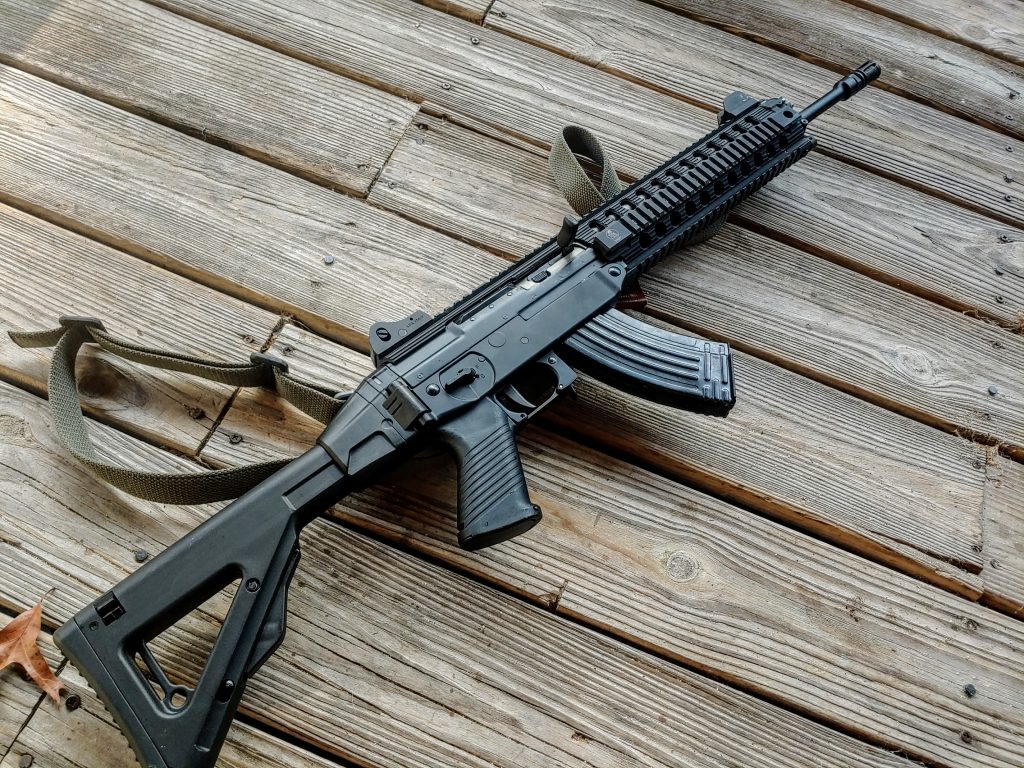
The weapon’s upper and lower can be separated almost identical to an AR 15 and it would be easy to attach different uppers for different uses including short barreled variants. Also, the gun sports a much longer sight radius than an AK, and it’s easy to attach sights that can cowitness with an optic.
The point seemed to be to create a rifle that functioned like a standard Western Rifle, with AK mags and ammo. It’s more modular, more customizable, and overall a much more modern rifle.
Why Did I want a SIG 556R
Something about its odd design spoke to me and I wanted one. Oh, I also had about 3k AK rounds and about 50 AK mags at the time. So, I wanted one the same reason a foreign army wanted one. Unfortunately, before I got my hands on one SIG killed the 556 series, and the Gen 1 556Rs in particular had a bad reputation.
This is what lead me to purchasing one at a ridiculously low price. It was apparently plagued by problems of all types. I purchased it, promptly contacted SIG about fixing it, and paid for a shipping tag. It took a few weeks, but they fixed the problem and shipped it with no further charges. After that my SIG 556R ran like a champ and continues to do so.
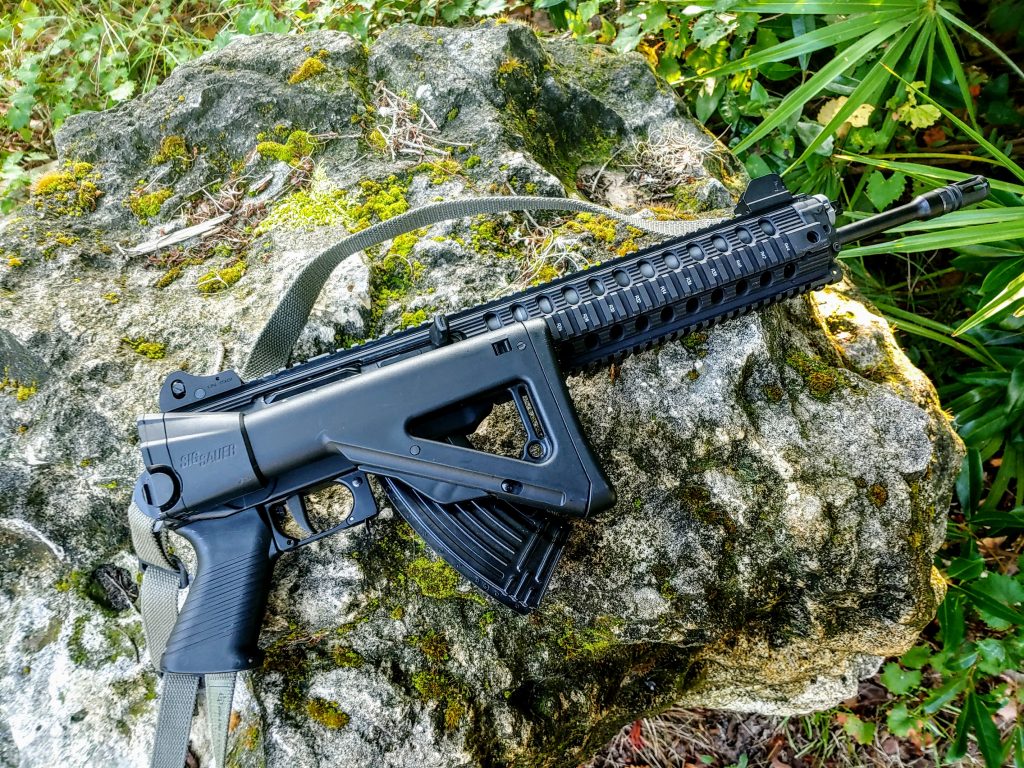
Mine is a Gen 1.5 model apparently, with Gen 2 models and later SIG 556xi models fixing the apparent reliability problems. Mine is also equipped with a Troy quad rail system which adds about three pounds to the gun. The rifle weighs 7 pounds unloaded so it’s not a heavy beast by any means.
The rail system makes it front heavy and unbalanced though. I wish I had standard handguards to swap out with to be honest.
Inside the SIG 556R
The SIG 556R is a piston driven rifle that utilizes a long stroke operating system. This means there is no need for a buffer system, so the rifle can and does have a folding stock. The rifle has a two-position gas adjustment system. The idea is if you shoot so much cheap ‘commie’ ammo through this gun it becomes too dirty to cycle, so you swap to the next position and keep going. Never something I had to use, but I appreciate the effort.
The 556R uses very AK like controls. There charging handle is firmly planted on the right side of the rifle. The SIG 556XI model would introduce a left-handed option later on. The magazine release is an AK paddle style as well. The safety is a much more modern ambidextrous model with a very short 45 degree throw.
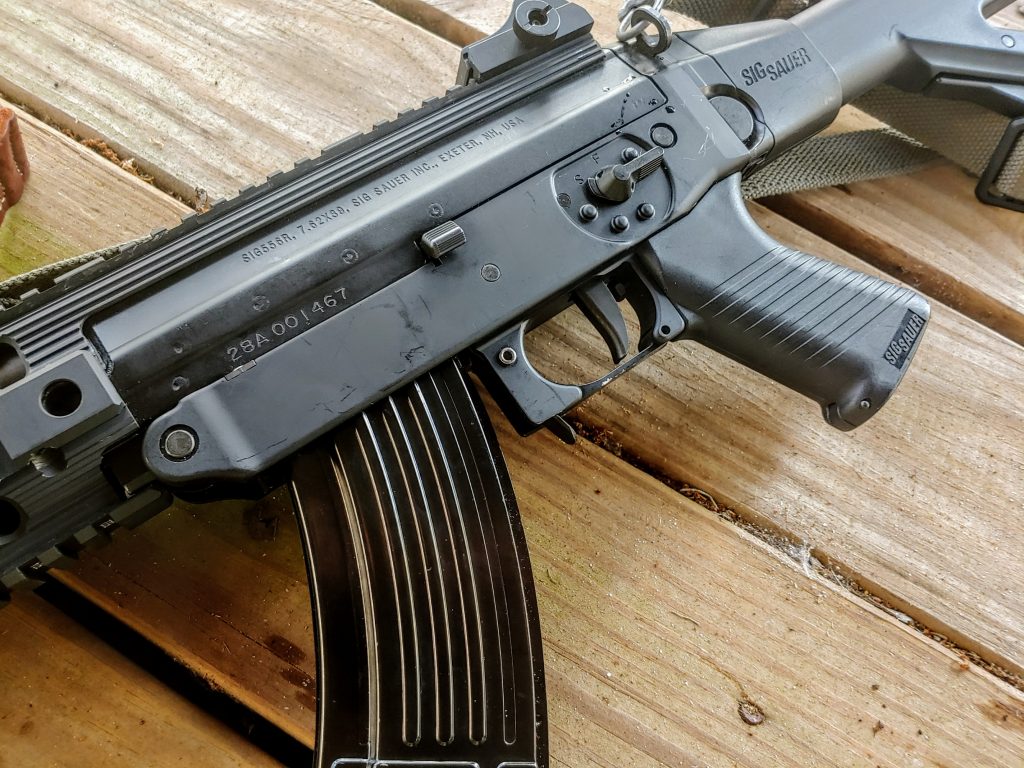
The stock is adjustable and has what feels like 4 collapsing positions. It’s hard to gauge because the stock doesn’t want to move and when it finally does it jumps wildly. This is certainly an issue, especially when I’m spoiled rotten on AR stocks that slide and move with absolute ease. The stock also does fold which is nice but doesn’t lock closed when I’m using the Troy rail.
Hitting the Range
The SIG 556R is a slick and fun shooting rifle. The trigger is nothing to write home about and is somewhat heavy and spongy. It works though. I’ve ran much better triggers, especially in AR style rifles. Recoil is very soft and muzzle rise is minimal. The recoil feels less than a standard AK and is certainly more comfortable.
The 556R is controllable as well, with very little muzzle rise. It comes equipped with a birdcage flash suppressor which does its job well. The stock is made from polymer and is robust and comfortable to shoot with. The stock provides a decent cheek weld that allows for comfortable shooting.
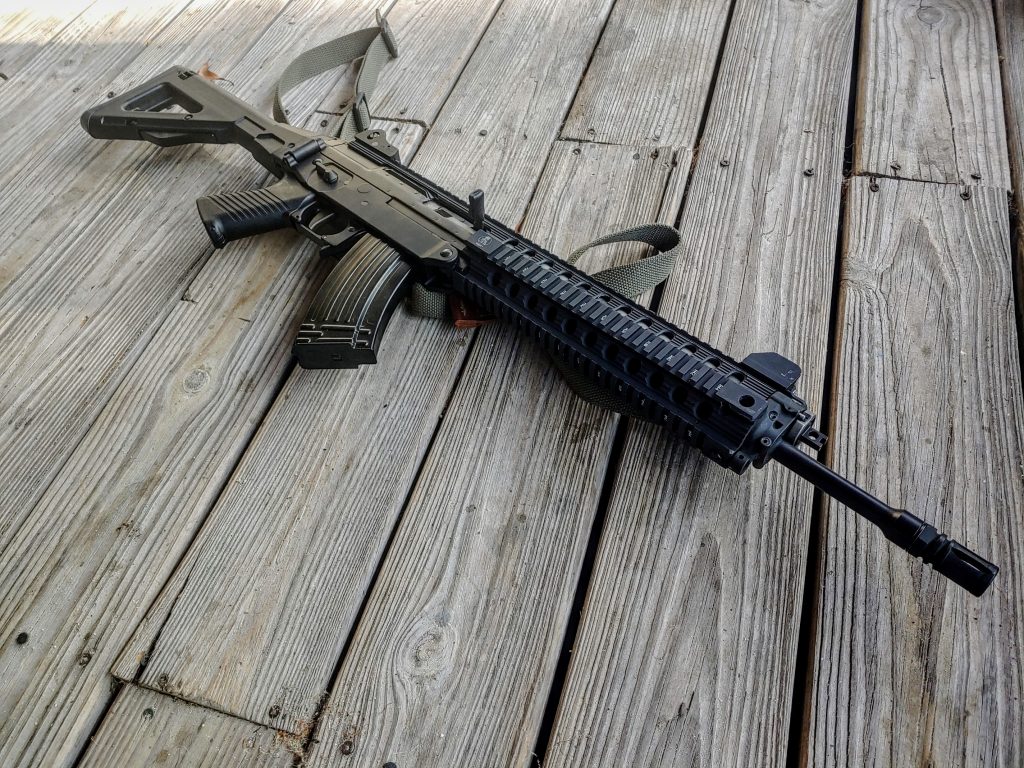
At 100 yards I can create 2-inch groups with steel-cased standard 7.62x39mm ammunition. With Hornady brass-cased goodness I can get down to about 1.5 inches. It’s not an MOA gun, but it’s closer than most AKs are.
After SIG fixed the gun it’s run 100% of the time with any ammo and mag combo I choose to shoot with. I’ve run Tapco, Korean, Magpul, Romanian, and Chinese magazines in the gun and they all work and function without issue. The Magpul magazines are slightly tight with the magazine release, but not bad enough to make running the gun difficult.
The gun runs like any other AK platform. There is no bolt hold open and you have to rock to remove the AK magazines. This makes reloading slower than an AR-style rifle. You can do the Call of Duty reload. Technically it’s a speed reload where you use your fresh magazine to release the old magazine and then reload. It’s a legitimate technique, but I first saw it in Call of Duty.
Hit the Ground Running
The SIG 556R rifle still features a lot of the AK’s weaknesses which does place it ergonomically below certain modern rifles. However, the gun excels past the AK in numerous ways, including ergonomics, recoil, controllability, as well as modularity.
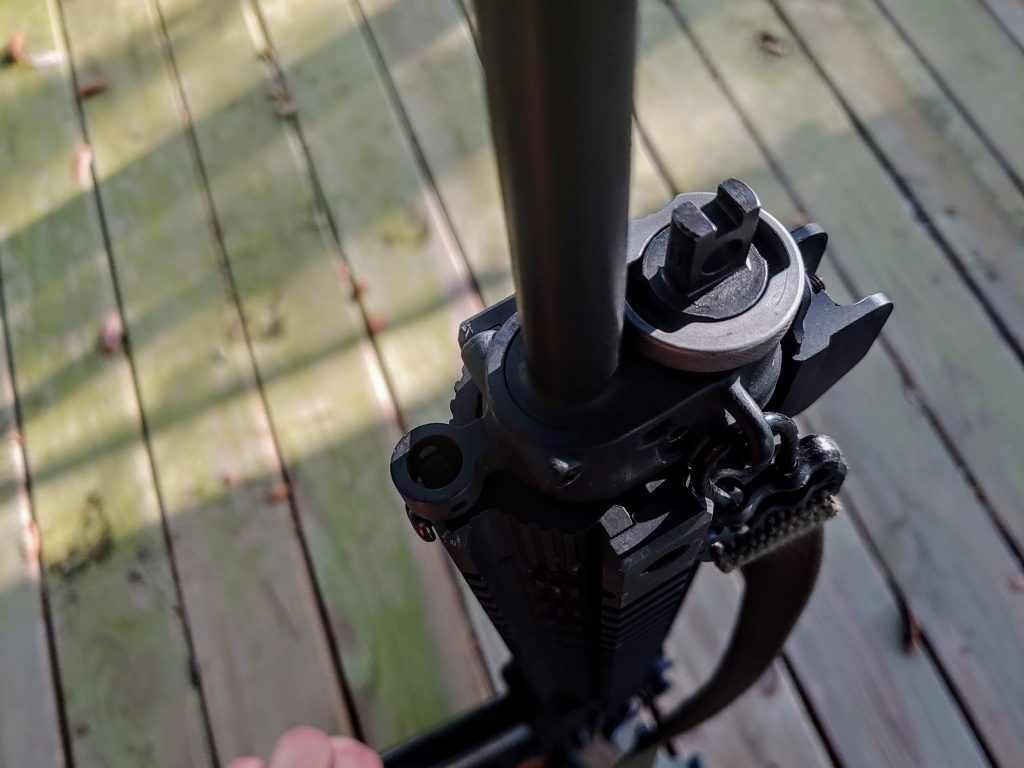
The SIG 556 rifles have unfortunately been killed off by SIG, and I don’t think they ever really got a chance to grow and expand. That being said they do have a cult following. That has produced a few aftermarket upgrades. This includes stock adapters to allow the gun to utilize AR stocks, as well as MPX stocks, and ACR stocks. Sampson produced a railed forend, but I believe it’s discontinued, as is Troy’s. I’m debating between an MPX adapter or a M4 style stock adapter.
I still enjoy the rifle, it’s a fun gun to shoot. It’s even more fun when I get a little tired of the same old same old. The SIG 556R is a unique weapon, and I wish the American market embraced them a bit more. However, we got what we got, so I’ll enjoy that while I can.
GVROs, ERPOs and Red Flag Laws
Following the El Paso and Dayton shootings this weekend, we heard from President Trump that it’s time to establish “strong background checks” and support “red flag laws” such as Senator Lindsey Graham believes can be enacted by bipartisan majorities soon in Congress.
DRGO has studied these topics for years, as have many other Second Amendment advocates. (You can see what we think about red flag laws here, and what a good background check approach would be here. )
These laws raise huge red flags in themselves to anyone who cares for civil rights and freedoms.
Background checks are too often inaccurate with too many false positives. Making them universal would be a necessary and probably irrevocable step toward facilitating universal gun registration. That, of course, would enable gun confiscation from legal gun owners if government decided to do so.
“Red Flag Laws” (or “Gun Violence Restraining Orders”, or “Emergency Risk Protective Orders”) are perhaps well-intended in the hope of preventing harm to people who might hurt themselves or others. There are reports in the media that such laws have probably prevented some suicides, and possibly some homicides—data that we so far haven’t seen. However, we do know of one death already in Maryland during an unexpected confrontation with police serving the order.
Should Congress and the President settle on a federal law promoting red flag laws, at least that is all they could do. Presumptively, the federal government can’t require all jurisdictions to intervene identically in cases of potential risk and confiscation of weapons. It can, as Graham’s bill provides, encourage states to pass these laws and provide grants funding their expenses. Yet this is another slippery slope of federal government control to be wary of.
At least 12 states plus the District of Columbia now have laws enabling gun confiscation when a judge finds that a subject might be dangerous. New Hampshire, where they claim to “Live Free or Die”, is currently a battleground for another, where DRGO is assisting the pro-rights side. None of these laws is fair or, likely, constitutional in design or application.
You’ll find a summary of DRGO’s opposition to these laws here, which links to our detailed Position Statement on Firearm Confiscation due to Dangerousness. As you can see in our Position Statement, the constitutional issues involve violations of the Fourth (“unreasonable search and seizure”), Sixth (“rights of the accused”), Fifth and Fourteenth (“right to due process”) amendments. We aren’t lawyers, but our Founders wrote so that laymen can understand.
Let’s think about what good laws allowing confiscation for very particular reasons might look like. (Hint: it’s all about due process and relevant interventions.)
Due process must be the cornerstone of any intrusion by government into any individual’s rights to freedom and property. This is the overarching requirement for legally sound confiscation of anyone’s property, which must include the presumption of innocence.
RFLs currently in place and in development allow a wide assortment of complainants to ask authorities (beginning with law enforcement and/or a court) to seize the subject’s property with no warning to the subject until the police arrive to serve the order. (These are called ex parte hearings, in which the subject is not to be present, and may not even be notified of the proceeding.) It is claimed that the right in 2 weeks or a month, then in another year or so, for the subject to appeal the order and demonstrate his safety and responsibility makes this fair. Not at all.
Only notice given to the individual of the complaint, followed by a court proceeding in which a prosecutor bears the burden of proving risk, would constitute due process, up front and as the events play out.
Unlike for most applicants for restraining orders against a feared individual, there are only minor penalties applicable for false reporting of dangerousness with firearms. We know there are many harassing restraining order requests; one reason is that penalties for false claimants are rarely or severely handed down.
An order to avoid a certain individual is one thing; an order for one’s home to be invaded and one’s property to be seized is a far greater imposition. Harsh penalties for demonstrably false reports have to be included and used, or this will become an even more favored means of retaliation in relationships. This should be no barrier to seriously concerned reporters.
When firearms are confiscated, other dangerous weapons also should be. This is why the focus on firearms only may leave the individual or others even more vulnerable. (Not that other firearms or weapons couldn’t be obtained by a seriously motivated person.) When they are, these laws must mandate careful guardianship of what can be many, expensive firearms that are damaged when stored in inclement conditions (for example, the many firearms confiscated from New Orleans citizens during and after Hurricane Katrina).
They don’t. Neither do they provide for the immediate return of wrongly seized firearms (or within any time frame). They must.
More comfortable options for what may be temporary loss of one’s weapons should be built in to these laws. When responsible family or friends are available to hold an individual’s firearm collection, this is far preferable to seeing them disappear into the bowels of a law enforcement headquarters. Obviously, strong penalties should the helper dispose, divert or return the weapons without legal sanction should be in place.
Last but not least, as important overall as our insistence on due process from beginning to end, gun (or general weapons) confiscation is no panacea. It is not even the most important intervention.
There are only two reasons confiscating weapons should ever be necessary: someone has criminal intent, or someone is influenced by a mental illness (and both may occur together).
Criminal intent has to be handled through our criminal justice system; mental illness has to be handled in our mental health system. Most current and proposed RFLs don’t require, let alone provide the means for, intervening in these ways, which misses the whole point of taking action based on well-founded suspicion that a person could do real harm.
It is vital that anyone subject to seizure of firearms be treated either as a criminal or for his psychiatric problem, in order for RFLs actually to promote individual and public safety. Generally speaking, laws already exist that can be exercised for these purposes. Where they don’t, they are greater priorities to add than a narrowly focused RFL alone.
Let me give an example of how this sort of legal process should work. In New York state, in order to retain even a psychotic, threatening patient more than a couple of weeks for treatment in a hospital (or to administer necessary treatment that would relieve the patient’s delusional fears), a strict legal process must be followed.
Several physicians/psychiatrists must apply for a hearing at which they must present evidence supporting the conclusion that the patient requires treatment to continue in hospital. The patient has no cost representation by an attorney working for a New York state agency that exists for this purpose. The case is argued, and the hearing office decides.
If RFLs were constructed to preserve individual rights, they would work that way. After what might have to be an emergency intervention, the subject would necessarily have the opportunity to get it canceled, with legal representation at no cost. The subject would be considered innocent unless demonstrated to require further intervention.
The “prosecution”, as it were, would have to prove to the court’s satisfaction that the individual presents a danger, and that managing that danger requires gun confiscation. And the outcome would have involve proper criminal and/or psychiatric intervention if indicated.
These are the reasons we in the liberty lobby continue to fight against RFLs as they exist in reality and in the minds of those who believe “something must be done”, seemingly always via increased government dominance of individuals. These are the reasons these laws violate not just the Second Amendment, but multiple others.
DRGO would love to see fair and constitutional laws that establish appropriate, useful interventions for potentially dangerous individuals. We are not optimistic that we’ll see them.
.
.

— DRGO Editor Robert B. Young, MD is a psychiatrist practicing in Pittsford, NY, an associate clinical professor at the University of Rochester School of Medicine, and a Distinguished Life Fellow of the American Psychiatric Association.
All DRGO articles by Robert B. Young, MD
Byrna HD Sootch Review
Byrna HD Personal Security Device is a Launcher for OC & CS Pepper Balls. This is a Non-Lethal option for Self defense.
Byrna HD Features:
- Gas-fired handheld personal security device in 7 colors
- Shoots 68 cal chemical irritant rounds
- Exterior construction made of glass-filled nylon
- Fits comfortably within a side holster
- Easily concealable
- 60 feet operational range
- Small recoil, lightweight and easy to use
- NO federal license to carry required
GarandThumb Control – On Current Events
Our favorite flanneled gun reviewer, Garand Thumb, has come to throw some good informative fuel to the intellectuals fires of the now raging gun control debate. We know a variety of proposals are being pushed, from universal background checks to a renewed assault weapons ban.
Yes a new assault weapons ban is in congress as S. 66 and because of the current public and political climate it has the greatest chance of gaining momentum in recent history.
This bill makes it a crime to knowingly import, sell, manufacture, transfer, or possess a semiautomatic assault weapon (SAW) or large capacity ammunition feeding device (LCAFD).
The prohibition does not apply to a firearm that is (1) manually operated by bolt, pump, lever, or slide action; (2) permanently inoperable; (3) an antique; or (4) a rifle or shotgun specifically identified by make and model.
The bill also exempts from the prohibition the following, with respect to a SAW or LCAFD:
- importation, sale, manufacture, transfer, or possession related to certain law enforcement efforts, or authorized tests or experiments;
- importation, sale, transfer, or possession related to securing nuclear materials; and
- possession by a retired law enforcement officer.
The bill permits continued possession, sale, or transfer of a grandfathered SAW, which must be securely stored. A licensed gun dealer must conduct a background check prior to the sale or transfer of a grandfathered SAW between private parties.
The bill permits continued possession of, but prohibits sale or transfer of, a grandfathered LCAFD.
Newly manufactured LCAFDs must display serial number identification. Newly manufactured SAWs and LCAFDs must display the date of manufacture.
The bill also allows a state or local government to use Edward Byrne Memorial Justice Assistance Grant Program funds to compensate individuals who surrender a SAW or LCAFD under a buy-back program.
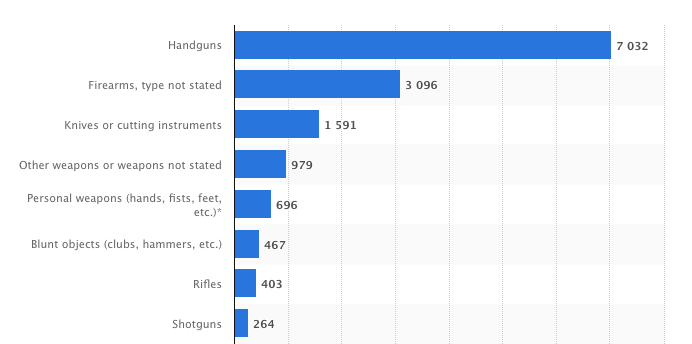
S. 66 is looking to impose a massive sweeping legislative change and drastic violation of the individual right to firearms ownership in a completely ineffectual manner. This either won’t be the last law they pass because it will be ineffectual (assuming it passed in the first place) or they really don’t understand how to effectively influence the homicide rate.
The legislation is looking to permanently hamstring millions of gun owners in order to curb a fraction of a fraction of a fraction of annual homicides. I don’t know how to get it through to people just how hail mary a pass this is to actually lower deaths, but imagine it’s a pass in a field 10 times as long, in hurricane level crosswinds, while blindfolded.
Nothing in these measures will save lives. This assault weapon ban and the other bread and circus proposals currently in Washington and the states have no realistic chance of impact. This isn’t “gun loving NRA lifer” talk. This is realistic analysis of rates of general criminal determent, non-compliance, societal outlook on violence, and ineffective removal of method. This law doesn’t remove rifles as a method, not even close. The tens of millions in circulation will remain so and still contribute to that small segment of total homicides for decades. The hundreds of millions of magazines will still be around too.
When you run incredibly generous numbers (like say the buyback proposed would pay $1.50 on the $1.00, MSRP, to remove these weapons and we get 50% compliance with the magazine ban) how would the law actually track a positive decline in homicides, mass or otherwise? Projected influence under ideal circumstances is less than year to year fluctuations, far less than the 2016 to 2017 difference.
Instead of focusing on keeping violent offenders incarcerated, especially those with criminal enterprise (gang) affiliation, which would actively cut into all those numbers, not just the rifle one, we use terrifying events to make ineffective policy. Great job guys… way to “do something” more than thoughts and prayers. Expecting this to work seems like a very cynical attempt at real earthly thoughts and prayers, as the politicians pray they can point to a number that says this hairbrained thought really worked.
Those that push these policy concepts are either completely ignorant or have a final agenda. Total firearm ban and confiscation by force is the only logical conclusion of their line of reasoning, regardless of what the gun controller camp says about their “respect for the 2nd Amendment.”
We are at the soap, press, and ballot box stage of this fight. I don’t expect us to leave that area anytime soon, and that’s a good thing. But we must be certain we stand firm against bad policies and actively support and promote good effective policies. We must keep speaking about why the bad policies will fail and why the effective policies will push the numbers they claim to want to influence.
Be the voices of reason even with an unreasonable audience, folks. This is going to be long fight.
The Saint Victor Rifle – A whole lotta Rifle
The Springfield Saint line of rifles have been pushing the boundaries of what a rifle is capable of being for under 1,000 dollars. The Saint Victor has an MSRP of $1,073 dollars, but retails for about 850. In a crowded AR market, it’s hard to stand out, but a classic and surefire method is to offer a lot of bang for your buck. The Springfield Saint Victor rifle is one of the latest models of the Saint and one of the most impressive. The Springfield Saint Victor comes in rifle, SBR, and pistol variant. The Saint Victor also comes in a 308 AR 10 model. Today I have the Victor rifle variant in 5.56.
What’s In the Saint Victor
The Victor offers shooters a 16-inch CMV barrel with a 1:8 twist rate. Around the barrel we have a 15-inch M-Lok aluminum free float handguard with Springfield Armory locking tabs.
The Saint Victor comes with SA flip-up iron sights which is a major relief in my eyes. The trend of selling rifles without sights, especially higher end rifles, is dumb. If a rifle doesn’t have sights its not a complete rifle. Beyond that the rifle comes with lots of Bravo Company furniture. This includes a Bravo Company Mod 3 pistol grip, a Bravo Company trigger guard, and a Bravo Company stock.
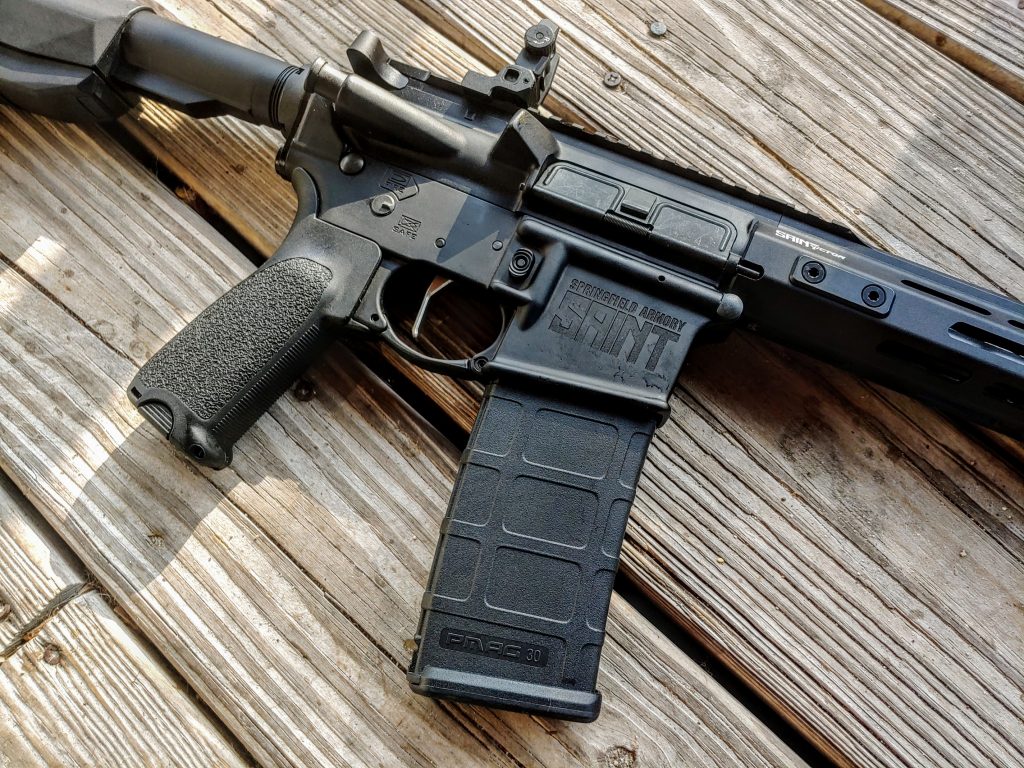
The pistol grip is nice, as is the trigger guard, but I love the stock. This has to be one of the more comfortable stocks and is certainly one of the most stable carbine stocks on the market. The Bravo Company Gunfighter stock offers an excellent cheek rest, is 100% beard friendly, and is an overall excellent stock. I could do an entire review just on it.

The Saint Victor also comes with a Spring Armory muzzle brake, a QD mount in the end plate, and a flat faced nickel boron trigger. The entire package is well put together and an impressive package for under a thousand dollars. I’d make one change and that’s to add an extended charging handle to make it easier to use with an optic.
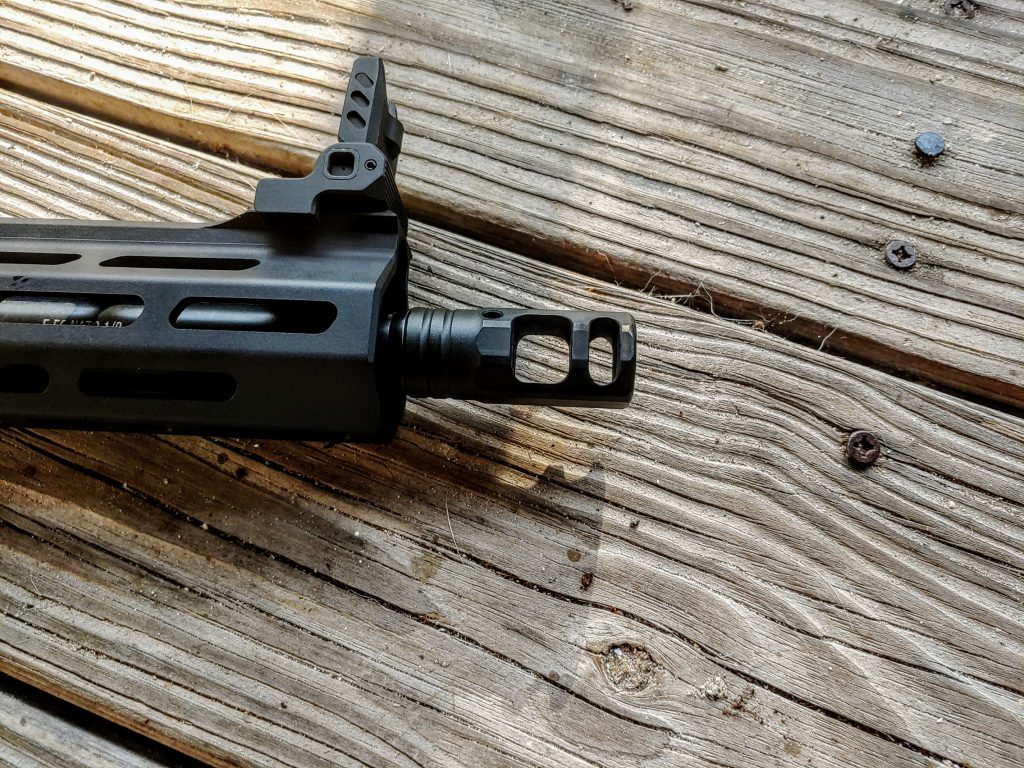
The Saint Victor comes together to be a complete package of a rifle. The Victor is well made, and Springfield did an excellent job at designing it. The lower is a stock standard forged model, very similar to any other lower on the market. Be it an Anderson, a Colt, an 80% Lower, or any other Mil-Spec manufacturer. The Victor also only weighs 6 pounds and 9 ounces. I love lightweight rifles and the Springfield Victor is an all together excellent package. The Victor also comes with one Gen M3 Pmag and a soft carry case which is a nice touch.
Range Time With the Saint Victor
The Saint Victor is a handy little carbine and it’s lightweight and comfortable to wield. I really love the stock and the thin handguard of the Victor combined with the Bravo Company grip makes every point of contact a comfortable one.
The gun is quick and easy to shoulder making it an excellent for quick reactions. Going from low or relaxed ready to an accurate shot on target can be done is less than a second. I found this out through snap drills where I aimed to hit a headshot at 25 yards starting at the low ready.
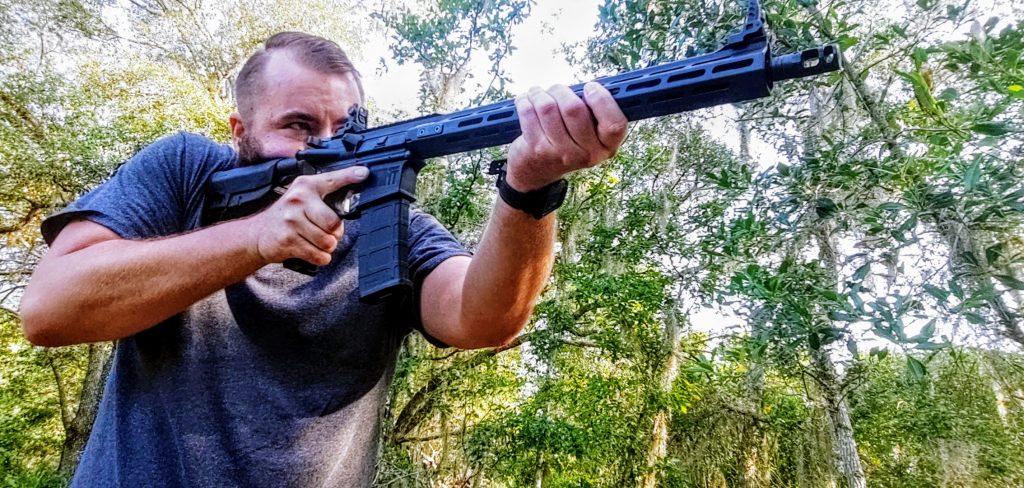
The gun has very little recoil and the muzzle brake does its job very well. Admittedly it’s freakin loud and your fellow shooters to your right and left may not like it. The AR in 5.56 is already very easy to control, but the Victor’s brake makes it even easier.
The 15-inch M-LOK rail is plenty comfortable, but it also heats up fairly fast. I shot the Table 5 USMC close quarter’s shoot and by the end the rail was nice and toasty. On top of the fact it was 96 degrees and I was in the sun so that didn’t help. Gloves will be your friend if you decide to amp up your shooting.
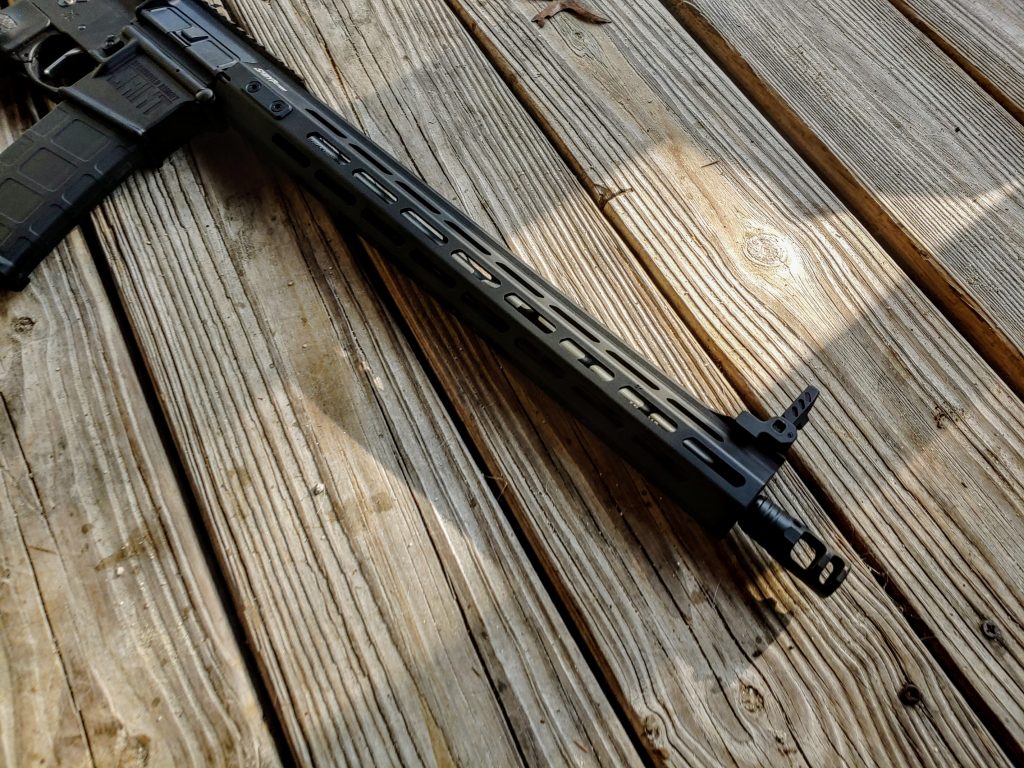
Accuracy wise the gun is certainly impressive. The flat trigger offers very short travel and a is nice and crisp as it breaks. The reset is short and tactile. On top of that the included irons are solid and well done. At 100 yards the rifle is capable of producing 1 MOA groups or better in the prone position, and an optic obviously helps, but irons can do it too.
Killing It
Shooting the USMC Table 5 drill turned out to be an awesome way to test this rifle. This drill required engagements at multiple ranges and done so with a par time. I had zero issues getting a perfect score with the Saint Victor. I also ran through drills like the Box Drill and Failure to Stop drill well below the required par times.
The lightweight design also helps with getting the gun from the low ready and into action quickly. You can drive the rifle easily between targets, and between different points of aim on the target. Placing round after round in the head and chest of my targets offered little challenge with the Saint Victor.

Reliability wise I ran Monarch, Wolf Gold, and Hornady training ammo without any issues in the Victor. We hit several hundred rounds between multiple runs of the USMC Table 5 shoot and shooting for accuracy. Magazines used were the included PMag as well as my favorite Lancers.
All in all, the Saint Victor is an excellent rifle, a well-made, well designed and well outfitted rifle. The price point makes it very attractive for those looking for a high-quality rifle. It represents an amazing value, and while they are certainly cheaper rifles the Saint Victor is still an excellent bargain when you combine the features and design.
Kimber SP (CDP)
Kimber’s Custom Defense Package is the ultimate in concealed carry design. It comes with the standard Kimber EVO SP features like a beveled magazine well, deep crown barrel and TRUGLO Tritium PRO, but has a streamlined carry melt treatment for improved draw and reduced chance of snagging on clothing.
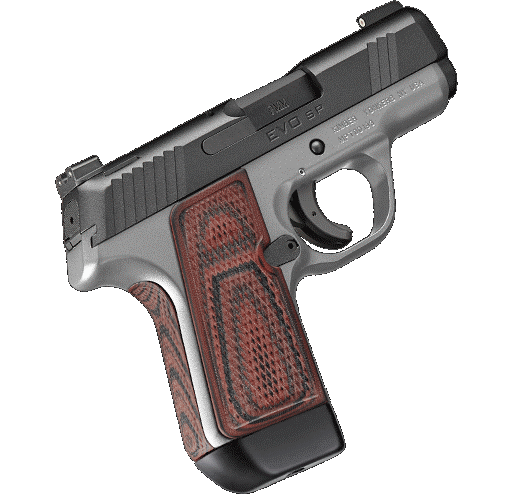
THE TRP 10MM 6″ – AN ENHANCED CONFIGURATION
Accuracy. Power. Speed. For as long as there has been shooting, whether it be for hunting, self defense, sport, or any other reason, these three aspects have embodied an idea of balance. This saying has literally become iconic, and not only is it an apt description of key shooting aspects that most are trying to equalize, but it is constantly applicable across all manner of shooting.
Dedicated and serious shooters are always looking for a better way to accomplish hitting a target, whether that is in the application of shooting (the accuracy and speed part) or an increase in power. Despite current trends, there are still many shooters who desire a cartridge that represents more power than just “good enough,” especially for a specific task or purpose. More power will always be more power, but this constant search can also lead to excesses in one direction or another. However, if we use this axiom of accuracy, power, and speed to measure a pistol itself, what results would we gather?
Enter the TRP 10mm RMR
This new offering from Springfield Armory takes the existing TRP 10mm 6″ and steps it up a bit. When compared to the original TRP 10mm, the addition of a Trijicon RMR®(Ruggedized Miniature Reflex) sight along with back-up tritium sights immediately stands out.
Similar to the existing TRP 10mm 6″, this new pistol uses a stainless steel match-grade bull-barrel with fully supported chamber, as well as a long recoil spring plug that allows for the use of standard government-length recoil springs. No special long-slide recoil springs needed.
However, what I think is the most notable change for this gun is the long, full-profile, heavy dust-cover on the frame, as it puts more weight low and forward on the pistol, but more on that later.
So, applying the “accuracy, power, speed” maxim, how does Springfield’s TRP 10mm RMR 6″ measure up?
The Gun Control Tide is Rising
Red Flag Laws and Universal Background Checks appear to be the D.C. flavors of gun control that are most palatable. With even “pro-gun” Republicans stating their support for such measures in varying degrees it is becoming more and more inevitable that there is going to be pressure for something to give…
Anti-Gun Democrats that populate the 2020 presidential field are calling for far more, unsurprisingly. Buybacks, magazine bans, assault weapon bans, waiting periods, monthly limits, and the whole gun control dream buffet are all being proposed. The candidates are basically tripping over each other to see who can say it fastest and loudest is the only variance.
But not everyone is completely losing their minds. There is evidence in corners of the internet that people not only take the problems of violence in this country seriously but also have some much needed perspective on it. At least a little.
It’s not about what guns people have. It’s who has them.
Over at BigThink.com there is a rather well written article documenting two studies from Boston University that dug into CDC and FBI data. They found that banning certain “dangerous” guns was as bogus a tactic as we all believed it to be. They also found…
Neither study showed that certain gun laws cause homicide rates to go down, but both revealed associations that point in the same direction: There are fewer gun-related deaths in places where it’s harder for high-risk individuals to buy guns.
[Emphasis added]
As always, we have to be really careful about the whole correlation causation game. But it’s reasonable to assume that if we’re efficiently keeping firearms from those with violent histories they in turn aren’t using guns they don’t have to commit violence.
“Using completely different datasets, we’ve confirmed the same thing,” Boston University (BU) School of Public Health researcher Michael Siegel told BU’s The Brink. “The main lesson that comes out of this research is that we know which laws work. Despite the fact that opponents of gun regulation are saying, ‘We don’t know what’s going on, it’s mental health issues, it’s these crazy people,’ which doesn’t lend itself to a solution — the truth is that we have a pretty good grasp at what’s going on. People who shouldn’t have access to guns are getting access.”
But here’s the kicker. The dataset of “people who shouldn’t have access to guns.” is all an after the fact collected dataset. Someone does something illegal with a gun, commits a violent crime, and we all go “Oh, he shouldn’t have had a gun.” Duh. Hindsight being 20/20 and all. Timothy McVeigh shouldn’t have had homemade explosives or been allowed to rent a truck to haul them either.
The problem is that predicting future behavior is tricky on persons with no criminal history. That is a common trait among the mass killers, there may have been concerning signs in documented cases but convicted criminal history is rarer. This makes all efforts to reduce mass homicide a game of whittling percentages down to levels that end up being… nothing.
The numbers game and why the the politicos are lying to you.
As often as mass violence “appears” to happen it is still a statistical outlier. The reason is that a certain set of circumstances must all come together with means and motive. The means are prevalent and cannot be eliminated. The motive is extremely rare and can equally no be eliminated. Trying to eliminate all the outliers is a fool’s quest… but I’ll be damned if the Dems aren’t promising pretty much exactly that impossible scenario.
And it sounds good! Of course “preventing” mass attacks sounds good, let’s not let the impossibility of the task prevent that fantasy from being the headline. Of course they couch the promise in terms like “reduce” to insulate themselves when it fails.
The numbers say that mass casualty violence is not significant.
Its overall rarity does nothing to aid the victims directly in any manner, I know that. Neither does the overall rarity of drownings aid those who actually drown. But perspective must absolutely be maintained if we want to reduce violence and respond in the manners that will most often save lives.
We, through law, are looking to create a percentage reduction in the death toll. Most of the currently proposed gun control uses the psychological terror of the rare mass casualty incident to justify sweeping moves that are just thought up to see if it works and praying it makes an impact they can point too. They are not soundly structured methodical plans, its “do something” and “if it saves just one life.”
What Gun Control the study says made an impact
“What surprised us the most was that in states that enacted a combination of universal background-check laws, laws prohibiting the sale of guns to people with violent misdemeanors, and concealed carry permit laws, the homicide rates were 35 percent lower than in states with none of those three kinds of laws,” Siegel said. “The practice of keeping guns out of the hands of people who are at the greatest risk for violence — based on a history of violence — appears to be the most closely associated with decreased rates of firearm homicide.”
See, numbers game.
Every state in the nation has a concealed carry permit law so I don’t see how the metric 35% was compiled for states with “none of those three.” But Siegel’s last point is one of those “yeah, that’s already the rule. How’s that working out for us?” type statements. It brings us back to keeping people locked up who should be. Violent crimes that carry long harsh sentences will be done less frequently because of both the harsh sentence and those who would do them anyway stay in prison longer or forever. Science.
“Less frequently” The Narrative Game of Gun Control.
In 2017 there were 147 people killed in Mass Attacks in Public Spaces (US), what we think of as the typical mass shooting or mass casualty attack. In 2018 that number was 91. I cannot find the total firearm homicide number for 2018 but for 2017 it was 14,542. Total homicides were 19,510. Numbers are the CDC’s
A little quick math says that if we prevented every single mass casualty event, a noble and yet impossible goal, we would move the homicide rate by .75% We would decrease the firearm homicide rate, because those are the really bad homicides, by 1.01%. While the deaths themselves are not insignificant, especially to the families, that reduction in homicide is eaten by the year to year deviations. We wouldn’t even notice, not from the total number of dead. Just a change in the publicity of those deaths.
Let’s even say that 2017’s reactions and any law changes were all directly responsible for reducing the death toll in 2018. So it is down to 91 solely because laws were passed, it doesn’t work that way at all but let’s pretend. We dropped the mass casualty rate 38% through assumed direct legal action, an absurdly optimistic number… and reduced homicides by only .285%
Meanwhile – In 2017, the estimated number of murders in the nation was 17,284 (FBI). This was a 0.7 percent decrease from the 2016 estimate, a 20.7 percent increase from the 2013 figure, and a 5.0 percent rise from the number in 2008. (See Tables 1 and 1A.)
For all the legal efforts, for all the constitutional violations, for every mistake that will be made to enforce all the provisions of ERPO’s, Red Flag Laws, and the like, the stated goal is to shift the homicide rate by so little that it is would be lost in any given year to year variance.
Readers, we call that statistically insignificant. The efforts will net no gain.
But that doesn’t matter to the narrative of “Curbing Mass Shootings” and “Stopping Gun Violence” and any other beloved headline of the ‘do something/thoughts and prayers don’t work’ crowds.
Our Efforts
Where would our efforts be most fruitful? Where will we actually make progress in steadily lowering the death toll?
Siegel’s study already had that answer. “The practice of keeping guns out of the hands of people who are at the greatest risk for violence — based on a history of violence — appears to be the most closely associated with decreased rates of firearm homicide.”
Or, put most simply. Enforce. Existing. Law.
Holosun HS407C: The Newest Microdot
City of Industry, CA (Aug 13, 2019)- Holosun Technologies is pleased to introduce the latest in its lineup of micro red dot optics, the HS407C. The HS407C is an entry level pistol sized optic that features two of Holosun’s proprietary battery saving technologies, as well as a unique red 12MOA ring in place of the standard 2MOA red dot. This unique small optic built into a durable aluminum body is ideal for use on a shotgun or whatever the situation demands.
As an entry level micro optic, the HS407C is built for rugged reliability and dependability. The HS407C’s aluminum housing makes it durable, corrosion resistant, and lightweight while Solar FailSafe and Shake Awake technologies keep it running, no matter what. Additionally, the HS407C has an IPX7 waterproof rating which means that the optic can safely operate in wet climates.
Holosun proudly boasts a battery life of up to 100,000 hours, or ten years, on the HS508C. Holosun knows battery life is crucial and features Shake Awake technology that helps users preserve battery life by detecting motion, and a lack of motion, in the optic. When it senses the optic is no longer in use through movement it will automatically power down the L.E.D. to conserve battery life. Once the optic detects movement again, it immediately restores power to the L.E.D. so that the user never has to guess or wonder if their optic is active. If the unexpected should occur and the battery does fail, Solar FailSafe uses a small solar panel mounted on top of the HS407C to collect ambient light to provide illumination for red dot. The brightness of the L.E.D. varies depending on the amount of light in the environment so users will never have a dim red dot in daylight or one that’s too bright indoors.
The HS407C is unique to the Holosun lineup as it features a 12MOA ring only. This reticle style is favored among shotgun users as it can be used to help shooters predict their spread pattern more easily ensuring nothing misses the target. Additionally, this reticle allows users to see through it so it does not obstruct view like a large red dot might. This optic features ten daylight brightness settings and two night vision compatible settings as well.
Durability and affordability are where the HS407C excel. Even as an entry level optic, the HS407C still delivers strength, clarity, and a long battery life. The HS407C is available today at authorized Holosun retailers and through their website http://www.holosun.com. The HS507C is the sibling unit of the HS407C that adds Multiple Reticle System technology to the optic. With an MSRP of $270.58 the HS407C is an affordable micro red dot optic. For questions and retail inquiries please contact info@holosun.com for more.
“Buybacks” and Borrowed Emotion
I went away on a trip for a weekend and the country’s gone to hell again. Sheesh, can I not leave you people alone for two minutes???
Confisc…. I mean “buybacks” are in the news again. These political mental giants are the very illustration of doing the same thing over and over again and expecting a different result. Rushing to “do something” – or to be at least SEEN to be “doing something” – is the order of the day every time a tragedy happens. It doesn’t apparently matter if the “something” is effective, Constitutional, or even enforceable. It’s the “doing” that matters – so that everyone can pat themselves on the back, feel better about themselves, and go back to business as usual.
Too bad for the poor schmucks whose Constitutional rights have been trampled in the process – whether via 2A violations, or 5A and 14A “Due Process” violations. I’m looking at YOU, red flag laws. But shame on me confusing the issue with logic when people are busy having “Feelings”.
Obviously none of these people has looked at the compliance data on the New York SAFE Act “assault weapon” registration scheme that was rushed through after Sandy Hook. Can we say “single digits”? You could almost say that the single “digit” was a middle finger from otherwise lawful gun owners to the New York State government. Biden, the sudden tough-guy talking “buybacks”, would do well to take a lesson from history.
I have not heard a single “new” idea coming from a single politician when it comes to reacting to the latest mass shootings. They might as well push a button and play a recording. Second verse same as the first. It’s almost as bad as every war in Europe for the past several centuries. When in doubt – invade France. Except for these guys it’s when in doubt – call for gun control.
Has anyone introduced a law banning news agencies from trumpeting the name and photo and manifestos of these scumbags? Nope – because 1A. Never mind that this does everything to ensure the next mass shooter seeks similar attention. God Forbid that news agencies “do something” like this voluntarily, despite the fact that there is evidence to back it up.
Nope. It’s GUNZ – inanimate objects with no sentience or agency of their own. Why? Because as is my constant refrain, it is much easier to demonize an object than it is to modify human behavior. Except what needs to be changed IS human behavior. Did we have these copycat shootings before the advent of the internet and 24 hour news cycle? Not many. Read the linked article about the news and human behavior above.
It’s funny that we always get these finger waggling nannies who say “Now, now, don’t be so dramatic, no one wants to take your guns”. Except what is every idiot calling for? “Buybacks”, banning, and confiscation. That sounds an awful lot like “taking my guns” to me there, Skippy.
Does anybody care that NHTSA stats say that 30 people die in drunk driving accidents on a DAILY basis? Nope. Does anybody care that scores of people are shot in criminal activity in Chicago every weekend? Nope. Because logic doesn’t enter into it. It’s the public freak-out of the moment, and politicians seek to capitalize on that emotion by rushing bad ideas through the legislative process in the middle of the night before anyone has time to calm down and consider anything rationally. How do you think the NY SAFE Act got passed in the first place? So effective that, with its 4% compliance rate.
I’m not saying that public mass shootings aren’t tragic. They certainly are, and the pond scum that perpetrate them deserve to have their names erased from the book of humanity. But for all of the public spectacle and grief, they are still RARE. None other than Neil deGrasse Tyson pointed this out in a chart on social media, and was apparently crucified for it. When the public is hopped up on borrowed emotion – feeling all righteous and outraged on someone else’s behalf – trying to insert logic into the mix can produce a violent blow-back. Never interfere with someone else’s righteous indignation, lest they turn it upon YOU instead.
There are some who are even trying to hang the latest shootings on Trump – because he weighs as much as a duck apparently, and floats like very small stones. (Monty Python reference for those who are scratching their heads).
THAT is the level of critical thinking involved here. But unlike Monty Python’s witch hunt, it isn’t funny. When emotions run the world instead of logic and reason, it is in fact very, VERY dangerous.
Gun Control for Gilroy?
I’d like to pose a question to the experts on this topic: Is there a gun-control measure that could mitigate the risk of mass shootings in public venues, such as the one that occurred at the Gilroy Garlic Festival?
Whenever society is besieged by important problems, it turns to experts for insight. In this context, rank-and-file police and boots-on-the-ground infantry veterans are the experts—not chiefs, sheriffs or generals.
Mass shootings, particularly those occurring in public places, are currently the driving force for gun control. (School shootings are important but are a subset of all mass murders, even though they occur in nominally secured buildings.)
The Gilroy incident is an excellent case study. This public access venue was as well controlled as could be for such gatherings. The “gun-free zone” was secured by a chain-link fence and attendees were screened for weapons via controlled access. Nevertheless, the 19-year-old perpetrator bypassed the controls. Similarly, the Mandalay Bay shooter overshot the concert’s barriers from a high-ground position. What could conceivably be done to reduce mass shootings in such public venues? Most additional interventions for preventing either kind of attack would make the events undoable.
Further securing the perimeter is impractical. Whether there are 100 or 10,000 attendees, attackers can skirt or evade perimeter barriers like at Gilroy and Mandalay Bay.
Reducing the number of guns to prevent bad guys obtaining them would be impossible. There are 400 million guns in America. Suppose half are suitable for mass killing—that’s 200 million. Suppose the total was reduced by 95%? (Which is impossible, given the 95% plus non-compliance with recent orders to turn in outlawed firearms.) A crazy killer would still be able get access to one of them somewhere, all that he needs. If he couldn’t buy an outlawed or diverted commercial firearm, ones will be available that are fabricated in a cottage machine shop or smuggled from abroad.
Could we shut down cottage machine shops? Stop smuggling? Clearly, we’ve been ineffective in shutting down meth labs or stopping drug smuggling. We couldn’t do any better with guns.
Bear in mind that mass shooters, gang killings and suicides are vastly different in character. An argument can be made for saving a few lives in a population of 10,000 gang bangers by reducing their gun inventories from 9,000 to 8,000. However, no such case seems plausible for a population of 10 deeply disturbed mass killers who plan and prepare for their attacks for months. How do we find any of those 10? How do we disarm them or keep them from accessing the black market?
America has suffered relatively few mass public venue shootings, from unbalanced people with a variety of motives (and some with no explicable one). Who are the greatest threats? What if other kinds of threats change the whole battlefield?
America was asleep at the wheel with respect to the prospect of an attack by Japan before World War II. How about today? Could an unexpected attack come from some other Asian, Middle Eastern, African or Latin American country?
If Americans are concerned about the minuscule risk of being shot in a public venue by a domestic mass killer, then we should also be concerned by the potential for such an attack by foreign-influenced terrorists again. How could gun control possibly reduce this risk?
Positioning sufficient security personnel wherever they might be needed could help. But can American taxpayers afford a cop in every public venue? How many officers or armed guard would be needed to cover each place, not to mention metal detectors?
Gilroy and Mandalay Bay are cases in point. Both venues were adequately covered by police bearing handguns. Gilroy officers were close enough to run to the sound of gunfire and stop the attack within a minute. Their bravery and preparedness are to be applauded. Las Vegas officers were too far away from the shooter’s high ground position even to attempt to return fire with handguns.
It was purely a coincidence that police were in Mandalay Bay offices on other business and could reach the shooter’s position within minutes. Yet that shooter was still free to fire at will for 10 minutes until distracted by an unarmed hotel security guard approaching his door. Arguably, the Las Vegas Police failed to anticipate the potential for a high ground shooter. After all, the only comparable historical incident occurred half a century earlier in 1966, from the Clock Tower at the University of Texas-Austin.
The challenges described here are well beyond the ordinary attention of the American voter. Nevertheless, there is an audience qualified to advise: American law-enforcement officers and combat veterans. They understand mass shootings.
Cycle through the usual gun-control solutions: universal background checks, magazine capacity limits, semi-auto rifle restrictions, registration . . . Would any of these change the number of psychopaths determined to kill people at a public venue? Would any of these have the slightest effect on a foreign-influenced attacker?
Law enforcement experts and combat veterans could offer realistic, if ultimately limited, answers. Would enough police equipped with rifles in public venues stop or dissuade attackers? How much of the deterrent lies in knowing there are trained, official marksmen on duty, versus knowing that well armed citizens are on site?
I was prompted to think about this question at my village’s summer Gay Pride parade. A dozen cops clustered at the major choke point of the parade route to separate eight anti-Pride protesters from parade marchers and watchers. These cops could readily respond to ground fire with their handguns, but would be challenged if a shooter took a perch from a rooftop or a second-story window. I asked one why they didn’t have rifles. He responded hinting that their rifles were present but out-of-sight.
Did we learn anything from the UT-Austin Clock Tower shooting? In that now ancient case, students deployed rifles from their pickups parked on campus, and returned suppressing fire until a civilian and three police officers scaled the tower and killed the shooter. The outcome of that attack demonstrated how important armed citizens are at any venue.
.
.

—‘MarkPA’ is trained in economics, a life-long gun owner, NRA Instructor and Massad Ayoob graduate. He is inspired by our inalienable rights to “life, liberty and the pursuit of happiness” and holds that having the means to defend oneself and one’s community is vital to securing them.

